By JOHN FRYE
There are so many new and unusual tools that will make your work easier and save you time. Using the right tool at the right time is an art-and this article tells you how to be a real "pro."

above: Set of the most basic tools-those that every radio and TV service
technician must have. This particular assortment is available as a kit
from General Cement but other firms offer similar sets.
MANY electronics technicians are careless mechanics. Why, they ask, replace all four chassis bolts when two will do the job? After all, the important diagnostic portion of their work is done in "the little gray cells;" so the manual use of tools to perform the actual repair seems rather dull and boring after the intellectual excitement of using exotic instruments to corner the trouble. Still, repairing electronic gear usually ends with pulling tubes, moving wires, snipping out defective parts, installing and soldering in new ones, realigning tuned circuits-in short, with the use of hand tools-and the efficiency of the technician and the quality of his work is often judged by what he does with his tools.
Lack of proper tools may account for part of the technician's mediocre mechanical performance. Need for the proper tool can make a simple job time consuming, temper-fraying, and equipment damaging. On the other hand, possessing the correct tool saves the technician's valuable time and renders mechanical work much easier and more pleasant. So why doesn't he provide himself with proper tools? Because he is instrument-oriented. Electronic instruments, not hand tools, are the status symbols of his profession. He may trade his perfectly good v.t.v.m. in on a new digital type when he has only the same three worn-bitted screwdrivers he had when he opened his shop! Another reason for the technician's tool-poverty may well be that he simply does not realize what a rich variety of excellent specialized tools has been developed for his needs. Catalogues and magazine advertisements he usually sees devote more display space to service instruments than to hand tools.
This article will review many useful hand tools available to the technician, discuss their features and proper use, and list manufacturers and jobbers from whom the tools--or more information about them--can be obtained. Since electronic chemicals were covered by the writer in the May 1971 issue and solder and soldering equipment were discussed in the June issue, these items will not be included here.
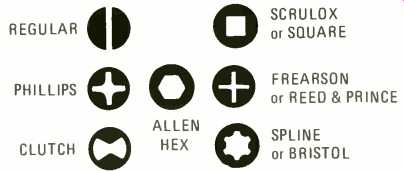
Fig. 1. You will need most, if not all, of these specialized screwdriver
bits. Their common names are indicated for each type. This photo is courtesy
of Jensen Tools & Alloys.
Screwdrivers
Let's start our discussion with screwdrivers. The cardinal rule in their use is: the driver bit should fit the screw slot correctly. With regular single-slot screws, the bit width should be slightly less than the full length of the slot, especially on flathead countersunk screws, because the slot length is less at the bottom than at the top. If the bit is as wide as the top of the slot, the corners of the bit will be sticking out at the bottom of the slot. On the other hand, if the bit width is too narrow, leverage is lost and the screw slot may be marred or the bit tip twisted. The thickness of the bit tip should not be so great as to prevent its reaching the bottom of the slot. The shaft of a cabinetmaker's screwdriver is round and of a diameter equal to the width of the bit so the tip can reach deep into a hole to turn a countersunk screw. Other screwdrivers may have round or square shafts. Heavy-duty screwdrivers often employ the stronger square design on which a wrench can be used for additional torque. See Fig. 1 for identification of screw types.
There are two kinds of cross-slotted screws: the Phillips and the Frearson or Reed & Prince. The former has modified U-shaped slots of uniform width, while the Frearson has V-shaped slots with tapered sides. While either driver will work, after a fashion, with either screw, both work much better with the screws for which they were intended.
In addition to using the proper type, it is also important to use the right size driver for these cross-slotted screws. Using too small or too large a driver is likely to ruin both screw and driver.
Other screws you encounter, especially if you do industrial electronics servicing, just often enough to make having proper drivers on hand a necessity are: the Allen head, clutch head, Scrulox or square head, and Bristol head types.
Each requires a specially shaped driver of exactly the right size and there is no good substitute.
Lincoln said a man's legs should be long enough to reach the ground, and a screwdriver should be long enough--or short enough--to reach and turn a screw wherever it may be used. That means you need stubby drivers, two-foot-long drivers, and offset drivers. And to start screws in those hard-to-reach places, you need screw-launching drivers which grip the screw head, not only for single-slot but also for cross-slot screws, such as those manufactured by Vaco.
For working on live circuits, screwdriver tips insulated by being plastic dipped are available and offer insurance against short-circuit damage. Screwdrivers using non-sparking, non-magnetic blades of beryllium-copper, such as those offered by Xcelite, are a must when working in explosive atmospheres or around sensitive color-TV tubes. Another must is a set of miniature jeweler's screwdrivers, such as those offered by Moody Machine Products, consisting of several single- and cross-slot bits that can be chucked into a knurled handle. If you work on miniature radios, these will be in constant use.
Finally, a man who removes and drives lots of screws, such as the chassis-remover-and-replacer in a large shop, may want to use speedy ratchet screwdrivers. The simple type allows the handle to ratchet on the bit with a choice of directions. The spiral type converts a pushing action on the retractable handle into rotation of the bit so that pre-started screws or screws being replaced can be seated with one motion. Here, too, the direction of rotation of the bit is reversible so that the tool can also be used for rapid screw removal.
Pliers and Snips
The variety of pliers and wire cutters used by the technician is comparable to the screwdrivers he uses. See Fig. 2.
Many of the pliers have been borrowed from other mechanical fields and adapted to his use. First there is the familiar two-position combination slip joint pliers that come to mind when you see the word "pliers." Every technician has a pair of these. He should also have their side-looking relatives with more positions and the water-pump pliers. A more sophisticated and smoother-acting version of the water-pump pliers is Channellock's tongue-and-groove pliers.
The common feature of all these is that the jaws can be kept nearly parallel while gripping objects of different diameters. If the technician does auto-radio work, he should have a pair of stubby jawed battery pliers for removing or tightening storage-battery terminal connectors.
But much of his work is concerned with maneuvering, shaping, and cutting wires; and there are several types of pliers specifically designed for his use. The granddaddy is the side-cutting electrician's pliers you see in the tool holster of every lineman. This tool is fine for working on large, heavily insulated wire. But the technician also needs at least one pair each of chain nose (a long-nose plier with smooth jaws), long nose, and needle nose pliers for handling small-diameter wire in tight quarters. Which he chooses for a particular job will depend on the size and stiffness of the wire, how much room he has, and how far he has to reach to get the wire. If he is affluent, he will find an exciting array of variations of these three types in which the tips are bent, curved, and offset to provide maximum ability to reach into difficult spots. For looping and forming wire, he needs a pair of round nose pliers designed just for this job.
A pair of flat nose, sometimes called duckbill, pliers will come in handy for locking or unlocking the tabs of components mounted on printed-circuit boards.
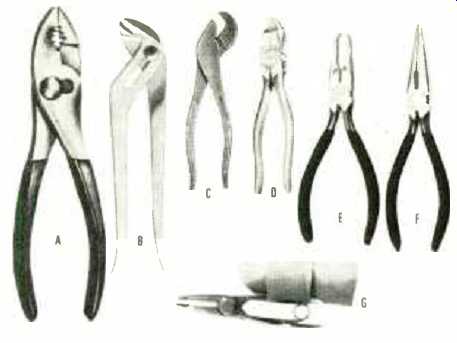
Fig. 2. Representative selection of pliers /cutters. (A) S-K combination
slip-joint, (B) S-K water-pump, (C) Channellock battery, (D) Channellock
lineman's, (E) Xcelite transverse cutter, (F) Xcelite radio & TV,
(G) Techni-tool "Deli-Cut."

Fig. 3. Various wrenches useful for service work. (A, B) Amtronix's
squeeze-action open and closed-end wrenches, (C) Vaco's crescent wrench,
(D) Channellock's "Griplock" crimping tool, (E) Xcelite's Allen-hex
assorted wrenches.
It used to be that all the wire cutting equipment you needed was a good strong pair of six-inch diagonal cutters--but not any more. Printed circuits and miniaturization changed all that. Using those six-inch cutters on a plug-in TV module would be as awkward as cracking peanuts with a sledge hammer. A glance at a good tool catalogue, such as the one put out by Techni-Tool, Inc., will reveal dozens of imported and domestic wire cutters and nippers-of every conceivable size, shape, and application. Transverse cutters will nip the wire off cleanly flush with the board. Probably one of the most versatile tools for the technician is a pair of radio & TV pliers that combine features of long nose pliers with diagonal cutters. The cutting section is a short distance back from the tip of the plier jaws.
If you do lots of miniature work, you will be interested in the tiny Deli-Cut instruments that fasten to the fingers with Velcro straps and are actuated by the opposing thumb.
With tweezers on one finger and a cutter on the other, you can position and cut wires the size of a hair without having to lay down one tool and pick up another.
A pair each of inside and outside snap ring pliers can save lots of time and temper if you encounter these spring-steel C-shaped retainers. They are so easy to remove and replace with the proper pliers that it is hard to believe how stubborn they are to manage without those tools.
The way the two halves of pliers and cutters are joined together becomes increasingly important with the need for keeping the jaws in alignment. A sloppy joint is tolerated, even desirable, with slip joint water pump pliers; but this is not true with precision cutters or pliers with long tapering jaws. Those jaws should stay in perfect alignment even when considerable lateral strain is exerted on the tips, as happens when they are used to twist things. Some pliers employ a steel dowel pin in one jaw that slips into a hole in the opposing jaw to maintain this alignment. Others depend on lapped joints and large rivets. Possibly the best solution is the box joint in which one half of the pliers slides through a box opening in the other and the lapped surfaces hold the jaws in alignment even when there is some wear on the rivet that serves as a bearing.

Fig. 4. Hammers and cutting tools. (A, B) S-K's ball-peen and soft-faced
hammers, and (C, D) cold and cape chisels.
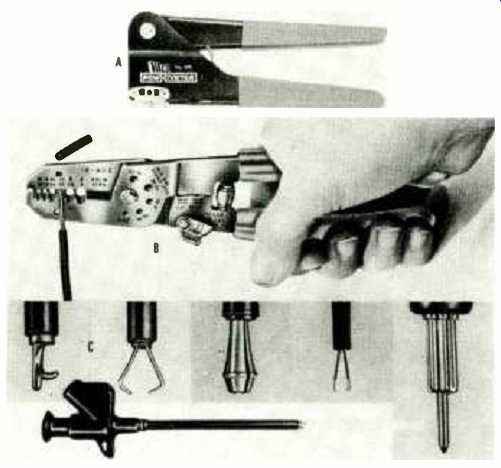
Fig. 5. Other useful tools that you should investigate. (A) Vaco's "PowRiveter," (B)
Holub's wire stripper, and (C) Rye's "Clever Kleps " test leads
in various configurations.

----------For house calls, a kit of essential tools, like this 23-piece
set from Xcelite, is both important and very "professional."
Wrenches
Wrenches are not as important to the electronics technician as to the garage mechanic, but electronic equipment is still enough of a nuts-and-bolts affair to make a good assortment of wrenches essential to the well-equipped service shop. See Fig. 3. Nut drivers are the most popular wrenches with technicians. These are actually socket wrenches with screwdriver-type handles. The best ones are made of high-grade steel so the walls of the sockets are thin enough to allow working in tight quarters and the shafts are hollow to permit turning a nut far down on a long screw.
Nut drivers are usually purchased in sets of six to ten drivers covering the majority of nuts encountered in radio and TV servicing. They can be had with individually color-coded handles or with separate shafts that snap into a common handle. Complete wrenches probably save time in bench work, while the snap-in type saves space in the tool box. Two or three drivers in the most popular sizes with extra-long shafts and another set with extra-short shafts are a good investment for solving special problems.
But there still will be places where a nut driver simply cannot be used, and that is where you need a set of miniature end wrenches. The offset type enables you to tighten or loosen a nut where there is only room for a small arc of action. Amtronix makes three unusual wrenches for special situations. The automatic ratcheting box wrench and automatic ratcheting open-end wrench provide for turning a nut by squeezing and relaxing the spring-loaded plier-type handles. The open-end wrench is for use on tubing or other places where you cannot slip the wrench over the end of the bolt. The spinning ratchet is actually a compact right-angle drive with a 1:1 gear ratio for driving socket wrenches. It is turned with a screwdriver-type handle, accepts all socket accessories, and has an optional ratchet feature.
Every shop needs two or three adjustable crescent wrenches and a multi-purpose plier wrench that can be locked onto an object with a spring-cam action. The latter is called a "vise-grip" by garage mechanics, but each manufacturer gives his version a different name. Channellock calls its two models "Griplock" and "Tog L-Lok." Xcelite sells a handy little wrench for removing the spanner nuts that hold antenna and speaker jacks in the cases of transistor radios and CB equipment. And no shop should be without a good collection of Allen wrenches for loosening and tightening Allen setscrews that are used profusely on dial knobs and in tape recorders.
Tool Kits It is impossible to have too wide a variety of alignment tools. The very one you lack will be the one you need. If you try to "make do" with a tool not intended for the job, a broken tuning slug is likely to result. Probably the best way to buy alignment tools is by kits. GC Electronics offers several kits of basic, deluxe, and specialized types as well as individual alignment tools of every kind and for every use.
Speaking of kits, Chapman Manufacturing Company has several midget ratchet kits for driving any kind of small to medium size screw you are likely to encounter. The various shaped and sized bits work in either the ratchet or spinner handle furnished with the kit. And if you are looking for complete tool kits containing all the tools you are ever likely to need on a job in field engineering or in telecommunications, you will find several in the catalogues of either Jonard Industries or Jensen Tools and Alloys.
Soldering Aids
As previously mentioned, solder and soldering tools have been covered in detail in another article. However, a few specialized soldering hand tools deserve mention here.
Technical Equipment Company markets a lightweight portable soldering iron powered by a rechargeable NiCad storage cell. The Express 2000 features interchangeable 40- and 25-watt tips, negligible magnetic field, an accessory charger, and complete electric isolation--an important factor in working with solid-state devices. Removing defective components from a printed-circuit board without damaging the board is always a problem, but the desoldering iron offered by Enterprise Development Corporation is a great help. It heats the joint with a special hollow tip and sucks the molten solder away by the action of a rubber bulb.
The technician encounters a few broken parts for which no replacement is available and that cannot be held together with tin-lead solder. This is a cue for Microflame's miniature welding torch that can be held, self-contained cylinders and all, in the palm of the hand. It furnishes a pin-point flame with temperatures as high as 5000 degrees F that enables you to weld and braze small articles of steel and other metals.
In ordinary soldering you need hand tools to seize, maneuver, and hold the wires, while clip-on heat sinks protect sensitive components from lead-conducted heat. Electronic Tool Company is one of several offering all sorts of seizing, tweezers, and wire-maneuvering tools. Just seeing the wires you are trying to solder presents a problem in miniature equipment; so you need magnifiers to help. You have a good choice of watchmaker's loupes, headband magnifiers, and illuminated bench magnifiers in the catalogue of Jensen Tools.
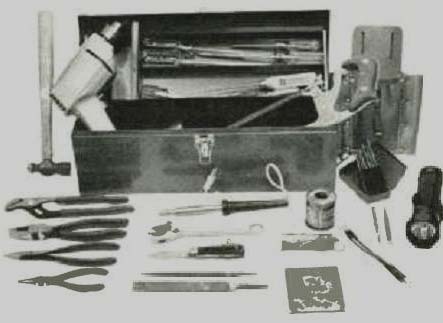
-------- If you do industrial maintenance and installation work,
you will need a tool assortment like this 25-piece kit assembled by Jensen
Tools and offered either with or without the drill.
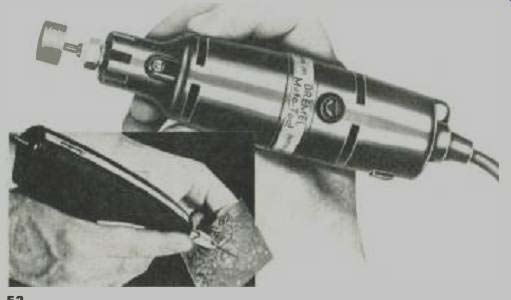
--------A universal "driver" like the Tescom "Moto-Tool" will
handle grinding, sanding, drilling, routing, and deburring jobs while
the tiny cordless drill is useful for on-the-job tasks and for PC work.
It is available from Jensen Tools.
Cutting Tools
The technician should have a good assortment of flat, knife-edge, round rat-tail, three-square, and needle files. In addition, he should have contact burnishers so he will not be tempted to use his files on relay contacts! He should carry a good pocket knife, and the bench should be equipped with scissors, tin snips, tapered reamers, a good hacksaw, and a tapping tool for tapping 6/32, 8/32, and 10/32 screws. Sometimes it is necessary to cut a new hole in a chassis to mount a new component or re-allocate one already present, and the chassis punches made by Greenlee Tool Company will allow you to cut any size or shape hole you desire by simply turning a wrench. Finally, a nibbling tool is excellent for cutting odd-shaped openings in plastic or thin metals of any sort.
--------------
Companies that make and /or distribute lines of hand tools.
Amtronix, Inc., Box 44 Chula Vista, Calif. 92012
Arrow Fastener Co., Inc., 271 Mayhill St. Saddle Brook, N.J. 07663
Channellock, Inc., Meadville, Pa. 16335 Chapman Mfg. Co., 30 Saw Mill Road Durham, Conn. 06422
Electronic Tool Co., 510 N. Dearborn St. Chicago, Ill. 60610
Enterprise Development Corp., 5127 East 65 St., Indianapolis, Ind. 46220
Gardiner Solder Co., 4820 S. Campbell Ave., Chicago, Ill. 60632
GC Electronics Div. Hydrometals, Inc., 400 5. Wyman St. Rockford, Ill. 61101
Greenlee Tool Co. Div. of Ex-Cello-0 Corp., 2136 Twelfth St., Rockford, III. 61101
Holub Industries, Inc., 413 DeKalb Sycamore, Ill. 60178
Injectorall Electronics Corp., 98-100 Glen St., Glen Cove, N.V. 11542
Jensen Tools & Alloys, 4117 North 44 St., Phoenix, Ariz. 85018
Utica Tool Co., Cameron Road Orangeburg, S. Jonard Industries Corp., 3047 Tibbett Ave., Bronx, N.Y. 10463
Klein & Sons Inc., Mathias 7200 McCormick Road Chicago, Ill. 60645
Kraueter/Dresser Hand Tool Div., 3201 N. Wolf Rd., Franklin Park, Ill. 60131
Microflame, Inc., 3724 Oregon Ave., S. Minneapolis, Minn. 55426
Moody Machine Products Co., Inc., 42-46 Dudley St., Providence, R.I. 02905
Rye Industries, Inc., 125 Spencer Place Mamaroneck, N.Y. 10543
Technical Equipment Co., Box 247 Bothell, Wash. 98011
Techni-Tool, Inc., 1216 Arch St., Philadelphia, Pa. 19107
Tescom Corp., Instrument Division 2633 Southeast 4th St., Minneapolis, Minn. 55414
Vaco Products Co., 510 N. Dearborn St., Chicago, 111. 60610
Wen Products, Inc., 5812 Northwest Highway Chicago, Ill. 60631
Xcelite, Inc., Thorne & Bank Streets Orchard Park, N.Y. 14127
---------------
Hammers and Hammered Tools
While he discourages the customer's hammering on his TV set to "fix" it, the technician still uses hammers ranging all the way from the tiny tube tapper to a heavy rubber mallet. In addition, he should have a small conventional hammer, a soft face hammer, and a ball peen hammer. He will need something to use these hammers on, and he will find an excellent assortment of prick or center punches to start drills, pin punches to knock out rivets, aligning punches to line up holes in two different pieces of metal, and cold or cape chisels for cutting off rivets in the S-K Tools catalogue of Kraueter /Dresser. See Fig. 4.
Power Tools
The electric drill is a much-used tool in servicing and should be selected with care. The author favors a double-insulated, variable-speed drill for safety and versatility, but each reader probably has his own preference. A hand-held high-speed grinding tool, such as the Moto-Tool sold by Tescom, will find dozens of uses in the shop and field. With the various furnished accessories, it grinds, sands, drills, polishes, routs, and deburrs wood, plastic, metal, glass, or ceramics. To identify positively your tools in case of loss or theft, a Model 21 electric pencil engraver by Wen Products will enable you to monogram steel, glass, aluminum, or whatever at a low cost in time and money. If you can afford it, a nameless heat gun, such as those offered by Techni-Tool, not only is excellent for shrinking tubing, desoldering, drying moisture out of parts, and speeding up the drying of finishes and epoxy, but it also is fine for triggering thermal intermittents, especially when used with an antagonist such as Injectorall's Chill-It circuit freezer spray. Finally, you need a bench grinder to keep tools in tip-top shape.
Miscellaneous There are many hand tools that are not absolutely essential, but they certainly save time and effort. See Fig. 5.
One such is Vaco's PowRiveter blind riveting tool that enables you to fasten an item to a surface while working just from one side. Another is a special staple gun by Arrow Fastener Co. for making safer, faster, neater wire and cable installations when setting up intercom and p.a. systems. Wire strippers are great time savers. Holub Industries makes the Little-7 wire stripper that strips wires from #18 to #6, bends them, and cuts them off. Other strippers from the same company will strip stranded or solid wire as small as #30. Injecting a signal, picking off a signal, or monitoring a voltage on a crowded printed-circuit board can present a short-circuiting hazard unless you have seizing, insulated test probes called Clever Kleps manufactured by Rye Industries. The spring-loaded claw, collet, or boathook ends grip the circuit-board test points while a wire or banana plug can be inserted at the rear of the Klep for connection to an instrument. Along the same line is the flexible mechanical finger manufactured in many forms. It, too, has a spring-loaded claw spread by pushing a button on the other end of the flexible shaft and is excellent for starting screws or nuts in hard-to-reach places or for retrieving the latter if they fall down into a cranny of the chassis. A crimping tool for attaching solderless connectors should also be in the tool box of the technician.
But the list of hand tools he can use is tremendous and still growing. The best way to appreciate this is to send for the catalogues put out by the suppliers.
Some of these manufacture tools specifically for electronics technicians; others sell a wide range of tools manufactured here and abroad for many mechanical applications. It is strongly recommended both types of catalogues be secured for you will often find a personal use for a tool designed for an entirely different field. The author's bench carries tools discovered in the hands of doctors, dentists, garage mechanics, typewriter repairmen, and even housewives. We who use tools have a common bond, and Winston Churchill, that international fixer, gave us our motto: "Give us the tools, and we will finish the job!"
=============
(adapted from: Electronics World magazine; Jul. 1975)
================